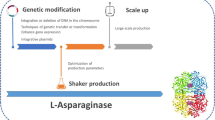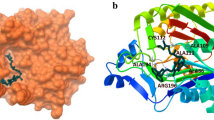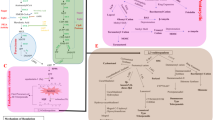Abstract
The chemoenzymatic synthesis of the tert-butyl (S)-6-chloro-5-hydroxy-3-ketohexanoate is described. Our approach relies on a highly regio- and enantioselective reduction of a β,δ-diketohexanoate ester catalysed by NADP(H)-dependent alcohol dehydrogenase of Lactobacillus brevis (LBADH). A detailed description of the scale-up of the enzymatic synthesis of the hydroxyketo ester is given which includes a scale-up of the substrate synthesis as well, i.e. the preparation of diketo ester on a 100 g scale. Furthermore, studies directed towards improving the co-catalyst [NADP(H)] consumption of the enzymatic key step by kinetic studies and application of a biphasic reaction medium were performed.









Similar content being viewed by others
Notes
After finishing the work described here, we became aware of several sources that reported about difficulties on attempted preparation of terminally chlorinated β,δ-diketo esters [22, pp 46–47]. Attempts to synthesize methyl 3,5-dioxo-6-chlorohexanoate […] using a literature procedure (Yamaguchi et al. [25]) were unsuccessful. The chloro 3,5-dioxo ester […] remained the most elusive in the syntheses described in this section.”
Attempted acylation under the same conditions (T < −65 °C, 1 eq, bisenolate) using methyl propionate and methyl butanoate as acylation reagents—two esters that do not carry an α-heteroatom substituent—resulted in poor yields (<25%). Large amounts of unreacted tert-butyl acetoacetate were found in the crude products of these reactions. These results are in accordance with the findings of Huckin and Weiler [23, 24]. Presumably, the α-chloro substituent of methyl chloroacetate 14 can stabilise the primary tetrahedral addition intermediate which prevents the harmful liberation of the newly formed keto group prior to hydrolytic work-up. The same protective effect is assigned to the N-methoxy group of Weinreb amides in this kind of ketone synthesis [26–28].
The thermodynamic equilibrium is constant and is determined to be \( K_{{{\text{prod}}}} = \frac{{{\left[ {{\text{NADP}}} \right]}{\left[ \bf 9 \right]}}} {{{\left[ {{\text{NADPH}}} \right]}{\left[ {H^{ + } } \right]}{\left[ {\bf 10} \right]}}} \ge 1.4 \times 10^{8} \) For determination of equilibrium conversion in biphasic catalysed reactions; cf. [29].
In terms of process parameters like pH, temperature, stirring, presence of organic solvent, etc. the requirement of a coupled second enzymatic system for cofactor regeneration can narrow the operational window to an unacceptable extent in difficult cases. In the present case, such a coupled enzyme reaction for cofactor regeneration would have to be compatible not only with the relative low pH, but also with the high load of 2-propanol, the high shear forces of the applied type of mixing, and the presence of the reactive alkylator 10 to name but a few. As an example, we observed strong inhibitory effects of 10 on formate dehydrogenase and metabolic activity of Saccharomyces cerevisiae in another study directed towards enzymatic reduction of 10.
The reverse reaction, i.e. the oxidation of 9–10 is also catalysed by LBADH. At 25 °C and the concentration of 9 being 15 and 2 mM NADP, the activity measured for oxidation is 3.5 U/mgenzyme. This value corresponds to 1% of the standard activity. Given the low reaction rate and equilibrium position under high 2-propanol concentration employed in this work, this reaction can be regarded as less important. Indeed it was seldom observed in the course of experimental work. Therefore it is disconsidered for our purposes.
Nevertheless, determination of V max and the relative activity is not necessary for the fed batch process development.
Similar observations were made in respect to HLADH [35].
For phosphate/citrate buffer solution at pH 5.5 it is 0.0008 h−1.
As reaction volume only the aqueous phase is considered. The organic phase can be regarded as an inert reservoir of substrate. Hence, the real concentration of substrate in the aqueous phase is not increased in the biphasic system [38].
References
Manns D (1999) Pharm Unserer Zeit 28:147–152
Endo A, Hasumi K (1993) Nat Prod Rep 10:541–550
Müller M (2005) Angew Chem 117:366–369
Müller M (2005) Angew Chem Int Ed 44:362–365
Baumann KL, Butler DE, Deering CF, Mennen KE, Millar A, Nanninga TN, Palmer CW, Roth BD (1992) Tetrahedron Lett 33:2283–2284
Wess G, Kesseler K, Baader E, Bartmann W, Beck G, Bergmann A, Jendralla H, Bock K, Holzstein G, Kleine H, Schnierer M (1990) Tetrahedron Lett 31:2545–2548
Beck G, Jendralla H, Kesseler K (1995) Synthesis 8:1014–1017
Thottathil JK, Pendri Y, Li WS, Kronenthal DR (1994) Squibb & Sons Inc., US 5278313
Mitsuda M, Miyazaki M, Inoue K (2001) Kaneka Corp., EP 1077212
Kizaki N, Yamada Y, Yasohara Y, Nishiyama A, Miyazaki M, Mitsuda M, Kondo T, Ueyama N, Inoue K (2000) Kaneka Corp., EP 1024139
Jennewein S, Schürmann M, Wolberg M, Hilker I, Luiten R, Wubbolts M, Mink D (2006) Biotechnol J 1:537–548
Kierkels JGT, Mink D, Panke S, Lommen FAM, Heemskerk D (2003) DSM, WO 03/006656
Kooistra JMHH, Zeegers HJM, Mink D, Mulders JMCA (2002) DSM, WO 02/06266
Mink D, Wolberg M, Boesten WHJ, Sereinig N (2004) WO 2004/096788
Wolberg M, Hummel W, Wandrey C, Müller M (2000) Angew Chem 112:4476–4478
Wolberg M, Hummel W, Wandrey C, Müller M (2000) Angew Chem Int Ed 39:4306–4308
Wolberg M, Hummel W, Müller M (2001) Chem Eur J 7:4562–4571
Villela Filho M, Stillger T, Müller M, Liese A, Wandrey C (2003) Angew Chem 115:3101–3104 (Preliminary communication)
Villela Filho M, Stillger T, Müller M, Liese A, Wandrey C (2003) Angew Chem Int Ed 42:2993–2996 (Preliminary communication)
Langer P, Krummel T (2000) Chem Commun 967–968
Langer P, Krummel T (2001) Chem Eur J 7:1720–1727
Johnson DV (1992) Dissertation, University of Exeter, citation, pp 46–47
Huckin SN, Weiler L (1972) Tetrahedron Lett 23:2405–2408
Huckin SN, Weiler L (1974) Can J Chem 52:1343–1351
Yamaguchi M, Shibato K, Nakashima H, Minami T (1988) Tetrahedron 44:4767–4775
Nahm S, Weinreb SM (1981) Tetrahedron Lett 39:3815–3818
Singh J, Satyamurthi N, Singh Aidhen I (2000) J Prakt Chem 342:340–347
Mentzel M, Hoffmann HMR (1997) J Prakt Chem 339:517–524
Eckstein MF, Lembrecht J, Schumacher J, Eberhard W, Spiess AC, Peters M, Roosen C, Greiner L, Leitner W, Kragl U (2006) Adv Synth Catal 348:1597–1604
Kragl U, Niedermeyer U, Kula M-R, Wandrey C (1990) Ann N Y Acad Sci 613:167–175
Villela Filho M (2003) Dissertation, University of Bonn
Weckbecker A, Humme W (2006) Biocatal Biotransform 24:380–389
Schubert T, Hummel W, Müller M (2002) Angew Chem 114:656–659
Schubert T, Hummel W, Müller M (2002) Angew Chem Int Ed 41:634–637
Zaks A, Klibanov AM (1988) J Biol Chem 263:8017–8021
Cornish-Bowden A (1981) Fundamentals of enzyme kinetics. Butterworth & Co. Ltd, London
Biselli M, Kragl U, Wandrey C (2002) Reaction Engineering for enzyme-catalyzed biotransformations. In: Drauz K, Waldmann H (eds) Enzyme catalysis in organic synthesis. Wiley, Weinheim, pp 185–257
Carrea G (1984) Biocatalysis in water-organic solvent two-phase systems. Trends Biotechnol 2:102–106
Author information
Authors and Affiliations
Corresponding author
Additional information
Dedicated to Prof. C. Wandrey on the occasion of his 65th birthday.
Rights and permissions
About this article
Cite this article
Wolberg, M., Filho, M.V., Bode, S. et al. Chemoenzymatic synthesis of the chiral side-chain of statins: application of an alcohol dehydrogenase catalysed ketone reduction on a large scale. Bioprocess Biosyst Eng 31, 183–191 (2008). https://doi.org/10.1007/s00449-008-0205-9
Received:
Accepted:
Published:
Issue Date:
DOI: https://doi.org/10.1007/s00449-008-0205-9




